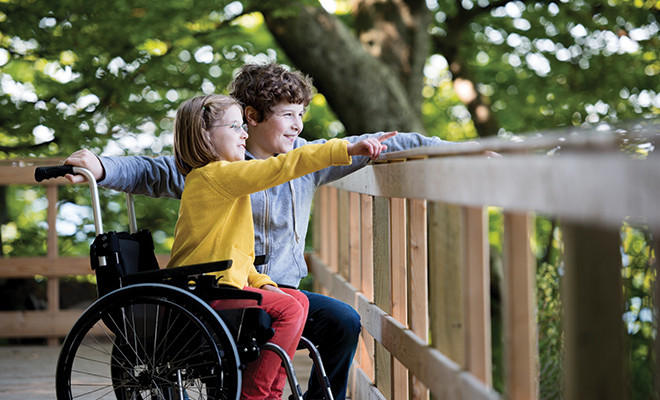
Engaging Your Child With Individuals With Disabilities
You’re out shopping with your child when you cross paths with another customer, and your child takes interest. Maybe this customer is deaf or blind. Maybe it’s someone who uses a wheelchair or walks with crutches. Possibly it is someone with a cognitive disability. Children are highly attuned to the environment and others around them, so it’s no surprise this would pique some curiosity. Your child might be closely observing the individual or even asking you questions about this person. What do you do?
You can help guide your child for how to respectfully interact with others who are different from him or her in any number of ways. Since you are the guide, first take stock of your own knowledge, experiences and potential biases for individuals with a wide variety of disabilities. This might not be easy to do, but it is important. As a child, were you told to avoid eye contact and pretend you do not see the person? Has it historically and presently been something that you feel very uncomfortable about, including feeling uncertain what to say or do? Without self-awareness and preparation, such thoughts and feelings may unintentionally come through in your words and actions. As noted, children are highly attuned to what is happening around them, and they will definitely take cues from you. So, think ahead of time about how you want to navigate such opportunities, and, as is possible, talk with your child to foster education and promote respectful interactions.
To get you started, learn more about disabilities together. A local library is a wonderful resource for finding age-appropriate materials. Read them together and discuss what is learned. For young children, some television programming such as Sesame Street will be helpful. With some frequency, children with disabilities are featured on the show, along with modeling from other characters for appropriate, socially-skillful interactions.
Returning to our situation of crossing paths with an individual with a disability, what should you actually do to best guide your child? Ironically, sometimes children are better equipped for such situations, especially as they are less inhibited with others and more inclined to be curious and unabashedly genuine in their interactions. As could be done with anyone, you and/or your child could make eye contact, smile politely and simply inquire how the other person is doing. Talk directly to the individual, rather than anyone else who might be present, such as a friend, family member, assistant or even interpreter. Also be mindful that you are speaking naturally, at your normal rate and volume. As with all people, some individuals with disabilities will want to be engaged in conversation and others less so. This is good to gauge in addition to providing sufficient personal space. If an animal providing assistance is present, it is especially important that the animal not be petted or engaged without permission.
If a conversation does develop, continue to interact with sincerity and positivity, along with awareness for the individual’s identity beyond the particular disability. For instance, discuss topics which you likely have in common, including places you frequent or interests and activities you pursue. Your child will then have a stronger grasp for understanding someone holistically, and, in this case, how the disability is just one facet of the person. There is so much more to recognize and appreciate, including the individual’s interests, likes and dislikes, aspirations, strengths and challenges. Your child can likely relate to that as well.
As is the case for most people, individuals with disabilities desire to be socially connected and included, having meaningful interactions and enduring relationships. Children are in a perfect stage in life for understanding and fostering connections with others, as they increasingly learn about the world around them and the many different kinds of people who inhabit it. By better understanding and interacting with individuals with disabilities, your child directly cultivates a depth of appreciation and empathy for diverse experiences, a foundation of interpersonal skills that includes respect, and awareness for the dignity and regard that is inherently important for everyone.
Along with efforts to better understand disabilities, learn how to use appropriate People First Language. Simply put, this means you acknowledge the person first, then the disability second. This reflects how the disability is a part of the person, but not his or her full identity. For example, say “the child who is deaf” rather than “the deaf child.” Avoid euphemisms such as “physically challenged” and “differently abled.” While People First Language is a helpful guide, each individual with a disability is the best resource for preferred terminology; respectfully inquire what terminology is desired by a particular individual.
Use People First Language:
Person with a disability
People with mental retardation
A person who has epilepsy
A person who uses a wheelchair
Accessible buses, bathrooms, etc.
Avoid:
The disabled
The retarded, mentally retarded
An epileptic
She has a birth defect
A person who is wheelchair bound
Handicapped buses, bathrooms, etc.







